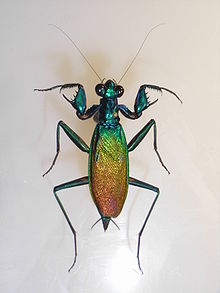| Metallyticus | |
|---|---|

| |
| Metallyticus splendidus | |
| Scientific classification | |
| Domain: | Eukaryota |
| Kingdom: | Animalia |
| Phylum: | Arthropoda |
| Class: | Insecta |
| Order: | Mantodea |
| Family: | Metallyticidae Handlirsch, 1925 |
| Genus: | Metallyticus Westwood, 1835 |
| Species | |
| Synonyms | |
| |
Metallyticus is a genus of praying mantis. It is the only genus in the monotypic family Metallyticidae. They are mostly found in South-East Asia. The species of the genus are dark, somewhat flattened and cockroach-like, and often with a cuticle that is reflective and metallic in appearance.[1][2]
The phylogenetic position of Metallyticidae relative to other mantis families has been studied using both morphological and molecular characters, but consensus on its placement has not been achieved.[3] Along with the genera Chaeteessa and Mantoida, Metallyticus is considered a member of the basal Mantodea,[3] though some scientists consider the application of this term to extant species to be misleading.[4] Metallyticidae species have several autapomorphic traits, including their metallic coloration and the enlarged spine on their front legs. They also have many plesiomorphic traits, including a relatively short pronotum and full wings in both sexes.[3]
Of the five species, M. splendidus and M. violaceus are the most abundant. Most specimens for scientific study have been found in Sumatra, Borneo, Java, and the Malay Peninsula.[3]
Species in this family are distinct from other mantises in their method of prey capture; Metallyticus species typically dart to capture prey, remaining close to the ground, rather than waiting to ambush. These species are usually found in or under bark of decaying trees.[3]
Species[edit]
- Metallyticus fallax Giglio-Tos, 1917
- Metallyticus pallipes Giglio-Tos, 1917
- Metallyticus semiaeneus Westwood, 1889
- Metallyticus splendidus Westwood, 1835
- Metallyticus violaceus (Burmeister, 1838)
References[edit]
- ^ "genus Metallyticus Westwood, 1835: Mantodea Species File". mantodea.speciesfile.org. Retrieved 2021-02-01.
- ^ "Metallyticus". tolweb.org. Retrieved 2021-02-01.
- ^ a b c d e Wieland, Frank (2008). "The genus Metallyticus reviewed (Insecta:Mantodea)" (PDF). Species, Phylogeny and Evolution. 1: 147–170.
- ^ Krell, Frank T.; Cranston, Peter S. (2004). "Which side of the tree is more basal?". Systematic Entomology. 29 (3): 279–281. doi:10.1111/j.0307-6970.2004.00262.x
External links[edit]
 Media related to Metallyticus at Wikimedia Commons
Media related to Metallyticus at Wikimedia Commons- Tree of Life - Metallyticidae
- Mantodea Species File (Version 5.0/5.0)